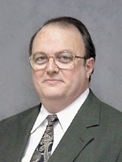
Am Fam Physician. 2000;61(11):3209
The four illustrations highlighting this page have several things in common: all of them originated from the Birmingham, Ala., studio of Floyd E. Hosmer, all of them tell a story in medicine, and all of them have draped covers of AFP with the glow of bosky light. The earth tones and mystical light that distinguish these works may have been inspired in part by a small patch of woods in Mr. Hosmer's backyard, where he says he solves lighting problems by observing the play and bounce of sunlight in the trees.
The top left drawing illustrates this issue's cover article,“The Painful Shoulder: Part II. Acute and Chronic Disorders” (see page 3291). You might remember seeing the other illustrations on AFP's covers: “Primary Prevention of CHD: Nine Ways to Reduce Risk” (March 15, 1999, bottom left), “Evaluation of the Acutely Limping Child” (February 15, 2000, top right), and “Nails and Nail Disorders in Children and Adults” (May 1, 1997, bottom right). Although this mini-gallery includes only recent illustrations, Mr. Hosmer's relationship with AFP started in the mid-80s. He recalls meeting Peter Stone, then AFP's art director, at a conference of the American Medical Illustrators (AMI). “I never worked so hard to get a cover assignment,” Floyd said, but the assignment, illustrating thread fractures of the elbow, appeared on the January 1988 cover, and his persuasive skills paid off for Floyd and the journal.
In addition to studying in nature's classroom, Mr. Hosmer has an impressive list of educational credentials, including M.S. and B.S. degrees in medical illustration from the Medical College of Georgia, Augusta, and postgraduate work in veterinary medicine at Auburn (Ala.) University, as well as a B.F.A. degree from Auburn University. Floyd served as head of the medical illustration division at the University of Georgia College of Veterinary Medicine in Athens from 1974 through 1977 and worked as a medical illustrator at Mayo Clinic, Rochester, Minn., from 1977 through 1989. He has done freelance medical illustrating since leaving Mayo.
Despite Mr. Hosmer's credentials and obvious talent, he says, “I'm just beginning to understand this work.” His main goal is to be the best possible artist and to always keep evolving. While working on a magazine cover, he keeps in mind that a cover has just a 15-second lifespan. If it doesn't grab its audience by then, the opportunity is lost. Developing a concept that tells the story is harder than doing the rendering, he thinks. Each cover is a challenge in conceptual design, and the ultimate success, he says, would be to make readers feel like they were falling hundreds of feet right into the cover.
While developing the current cover, he remembered a woman he knew with considerable shoulder pain. He kept this pain in mind as he sought ways to illustrate anatomic concepts, thinking first of placing a glassy human form in the background but, ultimately, choosing a moody, wood-cut figure. The illustration shows compression of the supraspinatus tendon, under the scapular bone, and arthritis of the joint surface itself. Although these conditions do not necessarily occur together, he sought to illustrate multiple concepts.
A lot of his pieces will be treated as a still life, like the limping child cover, or a landscape, like the nail disorders cover. He enhances fine art painting with computer techniques, such as the three-dimensional x-rays in the limping child cover. Once he finishes composing shapes and forms, he thinks about what light the forms call for and adds beautiful reflections. “That's where the fun begins,” Floyd says. And we couldn't agree more.

To learn more about Mr. Hosmer (right) and his works, visit http://home.earthlink.net/~floydh/illust.html.